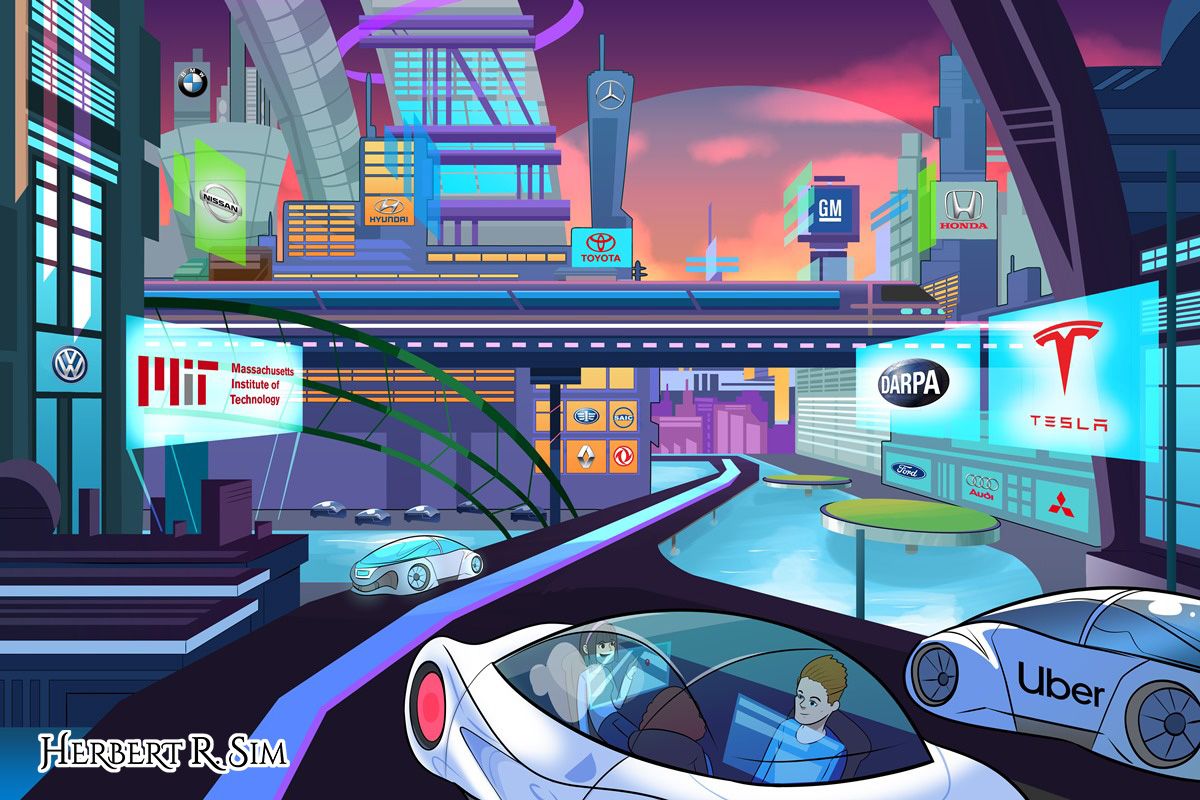
Above is my work-in-progress illustration of ‘The Future of Self-Driving Cars’ in GIF.
—————————————————————-
In 1995, a pair of researchers from Carnegie Mellon University rolled a black van fitted with the latest self-driving technology onto a 3,000 mile road trip from Pittsburgh to San Diego. The vehicle, dubbed the NavLab5, was retrofitted by the Robotics Institute at Carnegie Mellon, and while it did require some form of human intervention, it was still considered a significant milestone in the development of self-driving technology.
The feat injected excitement into what was then a muted self-driving research community, providing another platform where scientists and researchers alike could build from. Also known as autonomous vehicles, self-driving cars have been in development for several decades, with the first prototype developed in the 1980s.
A technology that’s highly sought-after
Since then, numerous companies have been working on developing self-driving cars. One of the pioneers in the field is Google, which started working on self-driving technology in 2009. Also known as the Google self-driving car project and later Waymo LLC, the Alphabet Inc. subsidiary had in fact carried out a number of self-driving tests using a fleet of automated Toyota Priuses, clocking a total of 140,000 miles.
In 2004, the US Department of Defense organised the DARPA Grand Challenge, a competition to encourage the development of autonomous vehicles. The competition comprised a 142-mile desert course, which the autonomous vehicles had to navigate without human intervention. Although none of the participating teams were able to complete the course, the event demonstrated the potential of self-driving technology and sparked a renewed interest in the field.
Other companies that have been working on self-driving technology include Tesla, which had announced its entry as a player in the field. Japanese car manufacturer Nissan also stated that it would begin testing autonomous vehicles on public roads in Japan, with its goal to have fully autonomous cars on the market by 2020.
Nissan’s announcement demonstrated the growing interest in self-driving technology and the potential for its widespread adoption, with this sentiment echoed by Honda, which announced that it had developed a self-driving car that was capable of navigating urban environments. The car, inspired by the Honda Accord, used an array of cameras, radar, and lidar to detect and respond to its surroundings.
Similarly, Mitsubishi unveiled a self-driving car prototype that very same year, one that was capable of driving on highways and other high-speed roads. The car used advanced sensors and machine learning algorithms which could help navigate traffic and even maintain ideal safety distances from other vehicles.
In China, the autonomous driving space is also taking shape, with a collaboration between First Auto Works (FAW), a Chinese automobile manufacturer, and the National University of Defense Technology (NUDT) to develop commercial driverless cars in China. In what could also be a first, this initiative is seen as an opportunity to apply military technology to improve people’s daily lives. The NUDT, especially, has a background not just in developing military technology, but is also working on civilian applications.
German luxury carmaker, Mercedes-Benz, is rumored to have worked on self-driving technology since the 1990s. To top it off, it has released the S-Class model that is capable of going auto-pilot. Nissan, Audi, and BMW are also among the slew of car companies that are throwing their hat into the self-driving ring.
Audi, on the other hand, had already rolled out an autonomous version of its TTS sports car in 2010. The vehicle, however, was primarily designed for use on a closed track but showcased the potential of self-driving technology in a high-performance context.
Despite numerous initiatives and tests to get driverless cars onto actual highways, self-driving technology is an intriguing prospect that could be applied creatively to provide mobility solutions. In 2013, researchers from the Singapore-MIT Alliance for Research and Technology (SMART) unveiled the driverless golf cart – complete with laser sensors and a field vision of 270 degrees – that could drive on its own and pick up passengers.
In the same regard, Induct Technology’s Navia shuttle is an electric, autonomous vehicle designed for low-speed applications, such as on university campuses or in industrial parks. It is also the first self-driving vehicle to be available for commercial sale.
—————————————————————-

In my final complete illustration, I added 21 brand logos, can you spot them all?
—————————————————————-
More boon than bane
One of the major benefits of self-driving cars is their potential to revolutionise transportation and reduce traffic congestion. With self-driving cars, traffic flow can be optimised through the coordination of vehicle movements, leading to a lower number of traffic jams, lesser congestion, and reduced travel times. Better yet, self-driving cars could even communicate with each other, complete with smart traffic systems to better manage traffic patterns and avoid bottlenecks.
As with any piece of innovative idea that reshapes how we live – in this case, transportation – safety remains a huge priority that will be key to any form of implementation or execution. Self-driving cars, in fact, has the potential to improve safety on the roads. With autonomous cars, accidents caused by driver errors could be eliminated, potentially reducing the number of accidents. These vehicles are also equipped with advanced safety features, such as collision avoidance systems, that can help prevent accidents from occurring.
Another perk of rolling out self-driving cars is that it reduces the environmental impact of transportation, contributing to a more optimised traffic flow while reducing carbon emissions and other harmful pollutants. Additionally, self-driving cars could be designed to be more energy-efficient, using advanced technologies such as regenerative braking and hybrid powertrains.
Although self-driving technology is often perceived to be a positive addition to society, there are challenges that await to be tackled. One of them involves developing a system that is capable of accurately sensing and interpreting the vehicle’s surroundings, which at this moment is still being fine-tuned by researchers. Essentially, self-driving cars rely on a combination of sensors, such as cameras, radar, and lidar, to navigate the roadways. These sensors must be able to detect not just vehicles and pedestrians, but also various obstacles as well as accurately interpret external movements.
Another huge challenge is the development of a system that can make split-second decisions in response to changing traffic conditions. Self-driving cars need to navigate complex traffic situations, such as merging onto a highway or to simply pass a slower vehicle. The DARPA Grand Challenge and Audi’s autonomous TTS were both attempts to address this challenge and demonstrate the potential of self-driving technology in handling complex situations.
Privacy and security are also concerns that detractors raise when it comes to self-driving cars. Autonomous vehicles rely on data collected from their sensors and other sources, and these data must be stored and transmitted securely to prevent unauthorised access or tampering. As more companies and governments become involved in the development and deployment of self-driving technology, it is important to establish clear regulations and standards for data privacy and security.
Despite the challenges, self-driving cars, as described earlier, are not mere figments of imagination. Their immense potential to help tackle traffic congestion, heighten safety levels, and negate the environmental impact of transportation will only be music to the ears of governments and sustainability proponents.
With continued investment and innovation, see Uber’s $375 million bet to purchase 2,500 self-driving cars from Google, autonomous vehicles may indeed become a common sight as research progresses. As with most disruptive ideologies and technological innovation, it is vital that self-driving technology must be developed carefully and deployed in a responsible manner – an issue really, of ensuring that benefits are maximised while risks get minimised.
